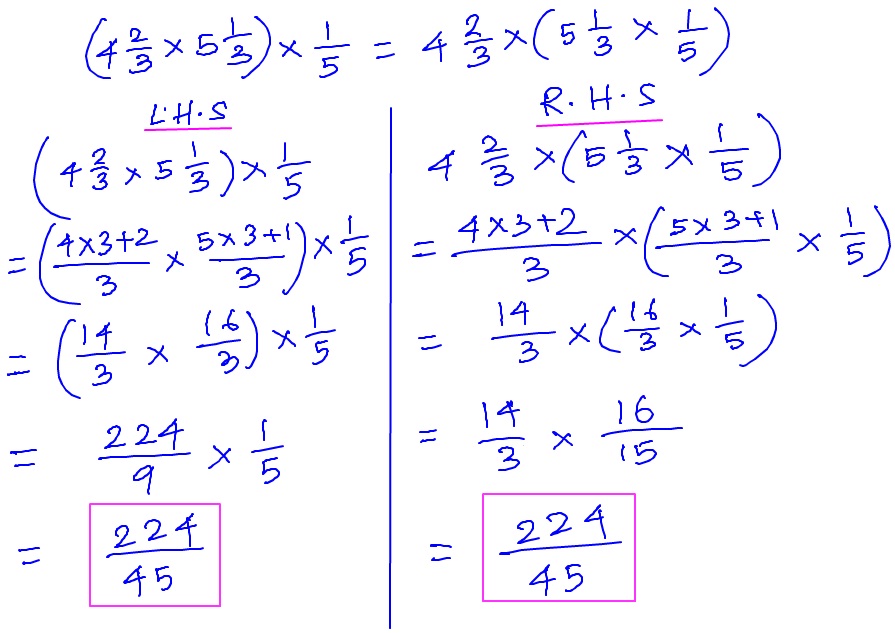Subscribe to our ▶️ YouTube channel 🔴 for the latest videos, updates, and tips.
Properties of Multiplication of Fractional Numbers
The properties of multiplication of fractional numbers are discussed here.
Property I: If two fractional numbers are multiplied in either order, the product remains the same.
or, The product of two fractional numbers does not change even if we change the order of multiplication.
Let us understand this property with the help of some examples.
For Example:
1. \(\frac{2}{3}\) × \(\frac{7}{5}\)
= \(\frac{2 × 7}{3 × 5}\)
= \(\frac{14}{15}\)
And now if you interchange the place of the fractional numbers the product does not change.
\(\frac{7}{5}\) × \(\frac{2}{3}\)
= \(\frac{7 × 2}{5 × 3}\)
= \(\frac{14}{15}\)
We observe that the product in both the cases are same.
So, \(\frac{2}{3}\) × \(\frac{7}{5}\) = \(\frac{7}{5}\) × \(\frac{2}{3}\).
2. (4\(\frac{2}{3}\) × 5\(\frac{1}{3}\)) × \(\frac{1}{5}\) = 4\(\frac{2}{3}\) (5\(\frac{1}{3}\) × \(\frac{1}{5}\))
3. \(\frac{1}{3}\) × \(\frac{5}{9}\) = \(\frac{1 × 5}{3 × 9}\) = \(\frac{5}{27}\)
\(\frac{5}{9}\) × \(\frac{1}{3}\) = \(\frac{5 × 1}{9 × 3}\)
= \(\frac{5}{27}\)
4. 8 × \(\frac{5}{7}\) = \(\frac{8 × 5}{7}\) = \(\frac{40}{7}\) = 5\(\frac{5}{7}\)
\(\frac{5}{7}\) × 8 = \(\frac{5 × 8}{7}\) = \(\frac{40}{7}\) = 5\(\frac{5}{7}\)
5. \(\frac{3}{8}\) × 1\(\frac{2}{3}\) = \(\frac{3}{8}\) × \(\frac{1 × 3 + 2}{3}\) = \(\frac{3}{8}\) × \(\frac{5}{3}\) = \(\frac{15}{24}\) = \(\frac{5}{8}\)
1\(\frac{2}{3}\) × \(\frac{3}{8}\) = \(\frac{1 × 3 + 2}{3}\) × \(\frac{3}{8}\) = \(\frac{5}{3}\) × \(\frac{3}{8}\) = \(\frac{15}{24}\) = \(\frac{5}{8}\)
6. 3\(\frac{2}{3}\) × 4\(\frac{2}{11}\) = \(\frac{3 × 3 + 2}{3}\) * \(\frac{4 × 11 + 2}{11}\) = \(\frac{11}{3}\) × \(\frac{46}{11}\) = \(\frac{46}{3}\) = 15\(\frac{1}{3}\)
4\(\frac{2}{11}\) × 3\(\frac{2}{3}\) = \(\frac{4 × 11 + 2}{11}\) × \(\frac{3 × 3 + 2}{3}\)= \(\frac{46}{11}\) × \(\frac{11}{3}\) = \(\frac{46}{3}\) = 15\(\frac{1}{3}\)
Property II: The product of three or more fractional numbers does not change even if we change their groups.
Let us understand this with the help of some examples.
1. \(\frac{1}{3}\) × (\(\frac{2}{5}\) × \(\frac{4}{7}\)) = \(\frac{1}{3}\) × (\(\frac{2 × 4}{5 × 7}\)) = \(\frac{1}{3}\) × \(\frac{8}{35}\) = \(\frac{8}{105}\)
(\(\frac{1}{3}\) × \(\frac{4}{7}\)) × \(\frac{2}{5}\) = (\(\frac{1 × 4}{3 × 7}\)) × \(\frac{2}{5}\) = \(\frac{4}{21}\) × \(\frac{2}{5}\) = \(\frac{8}{105}\)
\(\frac{4}{7}\) × (\(\frac{1}{3}\) × \(\frac{2}{5}\)) = \(\frac{4}{7}\) × (\(\frac{1 × 2}{3 × 5}\)) = \(\frac{4}{7}\) × \(\frac{2}{15}\) = \(\frac{8}{105}\)
Note: From the above examples we understand that, changing the order of fractional numbers does not change the product.
Property III: If a fractional number is multiplied by one, the product is the fractional number itself.
or, The product of a fractional number and 1 is the fractional number it self.
Let us consider some examples.
For Example:
1. \(\frac{7}{9}\) × 1
= \(\frac{7}{9}\) × \(\frac{1}{1}\)
= \(\frac{7 × 1}{9 × 1}\)
= \(\frac{7}{9}\)
2. \(\frac{5}{8}\) × 1
= \(\frac{5}{8}\) × \(\frac{1}{1}\)
= \(\frac{5 × 1}{(8 × 1}\)
= \(\frac{5}{8}\)
3. \(\frac{15}{19}\) × 1
= \(\frac{15}{19}\) × \(\frac{1}{1}\)
= \(\frac{15 × 1}{(19 × 1}\)
= \(\frac{15}{19}\)
4. \(\frac{27}{37}\) × 1 = \(\frac{27 × 1}{37}\) = \(\frac{27}{37}\)
5. 4\(\frac{3}{4}\) × 1 = \(\frac{4 × 4 + 3}{4}\) × 1 = \(\frac{19}{4}\) × 1 = \(\frac{19 × 1}{4}\) = \(\frac{19}{4}\) = 4\(\frac{3}{4}\)
So, we observe that a fraction multiplied by 1 is the fraction itself.
Property IV: If a fractional number is multiplied by zero, the product is zero.
or, The product of a fractional number and 0 is always 0.
Let us consider some examples.
For Example:
1. \(\frac{3}{11}\) × 0
= \(\frac{3 × 0}{11}\)
= 0
2. \(\frac{7}{15}\) × 0
= \(\frac{7 × 0}{15}\)
= 0
3. \(\frac{2}{27}\) × 0 = 0
4. 2\(\frac{3}{4}\) × 0 = 0
Property V: Multiplicative Inverse Property.
When the product of a fractional number and a whole number is 1, each one is a multiplicative inverse of the other.
Let us consider some examples.
1. \(\frac{1}{9}\) × 9 = \(\frac{1 × 9}{9}\) = \(\frac{9}{9}\) = 1
Here, \(\frac{1}{9}\) the multiplicative inverse of 9 and 9 is the multiplicative inverse of \(\frac{1}{9}\)
2. \(\frac{1}{18}\) × 18 = \(\frac{1 × 18}{18}\) = \(\frac{18}{18}\) = 1
Here, \(\frac{1}{18}\) and 18 are the multiplicative inverse of each other.
Property VI: When the product of two fractional numbers is 1, both are the multiplicative inverse of each other.
Let us consider some examples.
1. \(\frac{4}{7}\) × \(\frac{7}{4}\) = \(\frac{26}{26}\) = 1
Here, \(\frac{4}{7}\) and \(\frac{7}{4}\) are multiplicative inverse of each other.
2. 4\(\frac{3}{4}\) × \(\frac{4}{19}\) = \(\frac{4 × 4 + 3}{4}\) × \(\frac{4}{19}\) = \(\frac{19}{4}\) * \(\frac{4}{19}\) \(\frac{19 × 4}{4 × 19}\)= \(\frac{76}{76}\) = 1
Here, 4\(\frac{3}{4}\) and \(\frac{4}{19}\) are multiplicative inverse of each other.
● Multiplication is Repeated Addition.
● Multiplication of Fractional Number by a Whole Number.
● Multiplication of a Fraction by Fraction.
● Properties of Multiplication of Fractional Numbers.
● Worksheet on Multiplication on Fraction.
● Division of a Fraction by a Whole Number.
● Division of a Fractional Number.
● Division of a Whole Number by a Fraction.
● Properties of Fractional Division.
● Worksheet on Division of Fractions.
● Simplification of Fractions.
● Worksheet on Simplification of Fractions.
● Worksheet on Word Problems on Fractions.
5th Grade Numbers Page
5th Grade Math Problems
From Properties of Multiplication of Fractional Numbers to HOME PAGE
Didn't find what you were looking for? Or want to know more information about Math Only Math. Use this Google Search to find what you need.



New! Comments
Have your say about what you just read! Leave me a comment in the box below. Ask a Question or Answer a Question.